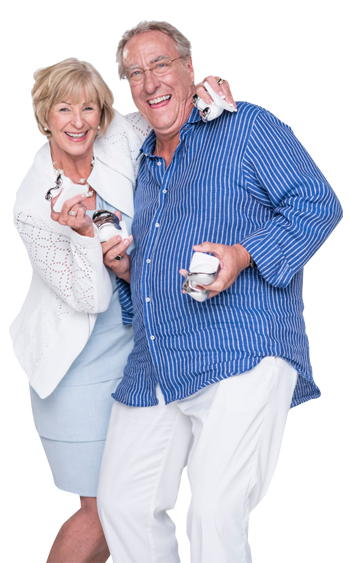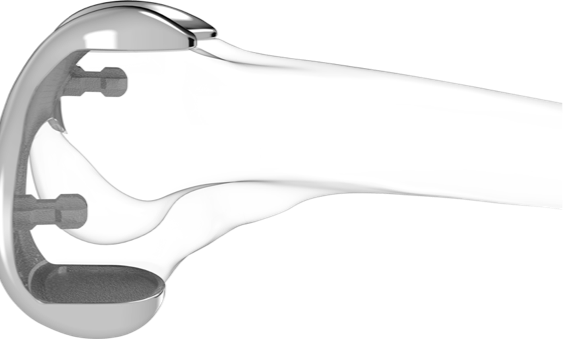Marcin Rozpedski: Chapter III - Words of Encouragement for Surgery
Originally posted to ProPickleball
After our post-op interview, we met with Marcin at Week 2, 9, and 16 to check on his progress.
At his two week visit to his surgeon Marcin was informed he needed to ramp up the efforts to overcome years of extremely limited range-of-motion (ROM). ‘It’s a slow process, I’m not bending enough – my doctor feels I’ve been too dependent on the Continuous Passive Motion machine. He’s cutting me off the CPM in three days…’. With a goal of 90° of flexibility, he was given a three week deadline to get there “or else he would do it for me”. Physical therapy sessions with Noé Sariban were 3x week at this point, and his words of ‘encouragement’ had the right motivating effect .

Noé pushing Marcin just a little bit harder – “You’re a wuss – suck it up!”
Not long after surgery, Marcin had tapered his pain meds due to several undesirable side effects, making these sessions quite intense. Marcin kept up with a series of exercises 4x per day and made consistent progress in muscular strength. He very clearly described some of the sensations he was experiencing as nerve pathways “started firing” through the continued stimulation of rehab – “Feels similar to growing pains”.
He made his 90° deadline. Nine week interview in a bit.
Previously we covered how Marcin’s personal implant was designed by Conformis, Inc using CT scans of his knee and a proprietary CAD process, the next steps to manufacture the implant are equally interesting.
The CAD files were first used to create parts in a 3D printer using laser-hardened plastic powder. These parts then were used to create the molds for castings of the femoral and tibial side implants. The files were also used to drive a computer-controlled milling machine, called a CNC mill, for elements like the meniscus replacement, essentially the friction-free polymer ‘bearing’ that the full weight of the femoral-side implant rests on. The process is fascinating; a long bank of industrial-strength 3D printers each take about 21 hours to print 5 different implant/installation kits at a time.

Industrial strength 3D printers creating custom implant & instrumentation mold elements
The output of these printers is a block of components resembling the plastic ‘tree’ of parts you pulled out of a Revell model kit as a child. These are then separated and prepared for the next steps in the manufacturing process – mold creation in the case of the implant or assembly of instrumentation. Note – the tolerance for these custom parts is a mere ± .1mm to the files generated from the patient’s original knee; when you look at the wide range in sizes of patient’s knees usually addressed by as few as only eight sizes, this capability for an essentially exact fit has a major impact on reducing ‘overhang’, a major cause of pain associated with artificial knee implants.

Tibial implant and meniscus replacement combined must bear 4x Marcin’s weight!
More on this amazing process shortly.
Marcin’s support group has played a big role in his recovery, with Carley and family adapting to a care-centric schedule those first weeks. Many people that had previously undergone surgery had words of encouragement – none closer to home than Kim Poppa Jagd. Not only was she one of the family and friends at Marcin’s side during the first days post-op, but she has lived this, successfully recovering from a total knee replacement just over a year ago, and returning to competition at the highest level as a finalist of the SrPro Mixed Doubles at Minto US Open Pickleball Championships. Her pre- and post-surgery story mirrored Marcin’s in several ways. She’d had been living in pain for two years; enjoying two hours of play followed by 22 hours of pain. Although frightened of surgery, Kim felt she had to pull the trigger soon. Not only was the pain motivating her to make the move, but she felt she had a narrow window to establish a strong position in the Senior Pro division. Seems her strategy worked.

Kim Poppa Jagd at the US Open
On the procedure itself, “The first weeks following the surgery can be difficult – the effects of the narcotics, the feeling of being alone. Then it breaks like a fever”. Those were positive words for Marcin to hear in the first days after his surgery, as they were for us. Marcin’s support group extended to his on-court training, accelerated with the help of Morgan Evans, Scott Burr (his cycling partner also), Greg Carter, Benjamin Druyon, Carley Rozpedski and the entire ‘Desert Storm’ group of players from the Palm Desert area.
At eight weeks we met again with Noé Sariban, Marcin’s physical therapist based at Shelley A. Cooper Physical Therapy. “For Marcin it was different than other patients at beginning – he was experiencing very different sensations and his nerves were more active.”
“A patient’s fitness going in impacts their recovery curve – this has really helped Marcin. Due to the extremely limited functionality of his entire knee complex prior to surgery, improving his range of motion has been the main focus. After reaching his 90° flexibility goal, we started to ramp it up. He got back on the bike outdoors, and by week four he was on the court starting with kitchen drills – play simulation helps! The mental component is important – a patient needs more than just a clinical environment. Getting out is very good for a one’s outlook!”

Noé Sariban, Marcin’s physical therapist based at Shelley A. Cooper Physical Therapy
How will he moving by the time ToC comes around? “Marcin’s been heavily compensating for two years – to compete at four months is aggressive – he’ll feel it!”. Marcin’s singles outlook in the future? “The stabilizing elements in a total knee replacement are different from the original knee. The cruciate ligaments are gone, replaced by an implant with posterior stabilization. To address the stability needed for the rigors of singles, Marcin will need to develop even more strength in his quadriceps. His progress in addressing the imbalance from the period before his surgery to today has been great.”
When asked for advice for future patients, Noé, in his very frank manner, commented that “as a patient, you need to be prepared for some discomfort.” Noted.

Marcin on the court – post-op 7 weeks! Photo provided by MR.
At nine weeks we met with Marcin – he was very upbeat. “ Noé’s been great! The clinic has taken me under their wing, helped with home visits and have given me great support!” At seven weeks his desk work restriction was lifted; but he’d already been on the court testing and pushing his movement starting with light rallies at the net, increasing his range each occasion. “I’m bending more and more – and I’ve been cycling with no clips to start rebuilding my cardio base, plus I’m actually teaching now with no pain at all! The throbbing pain I used to experience after play is no more, with the stiffness and numbness reducing each week – my nerves are firing and healing’.
The instrumentation, or installation tools, for a conventional knee replacement surgery occupy eight trays in the operating room. That many are needed due to the range of possibilities a surgeon must address to adapt the patient’s bone structure to accept the standard implant shape. In Marcin’s case, the instruments specifically designed to fit his individual bone shape reduced both his time in surgery and the potential for contamination. From an operations expense, the hospital only used one tray of single-patient instruments – those eight trays used with a conventional implant would have required sterilization following surgery.

Six edges smooth the implant’s curve-fit to Marcin’s femur
A final note highlighting the innovation and mechanical optimization in Conformis’ implant design. Typically the curved femoral implant is attached to the bone, mating to a coarse curve using five large cuts, or chamfers. Marcin’s implant uses six smaller chamfers, forming a smoother curve resulting in a 30% reduction in peak stress across any one point on his remaining bone structure.
Once finished, the implant components and instrumentation needed to install Marcin’s new knee were boxed up and shipped to the surgeon’s operating venue in a single patient, serial-numbered package. This ‘image to implant’, just-in-time process is a remarkably short five days after the patient’s files have been created by the design team. This means less inventory build-up – a significant cost-reducer.

Park Mehendale Conformis Director Manufacturing Engineering, holding ready-to-ship package

Marcin’s personal femoral-side implant!
At week sixteen we checked in on Marcin. The good news is that progress on the right knee has been great – at two weeks to go to his first event, the Tournament of Champions, Marcin felt he had reached 100% cardio readiness, with his overall functionality at 80%. Flexion is at 115° with an end goal of 125°-130°. Muscular strength in his right quadricep has improved well beyond his pre-surgery levels, and his practice sessions have been getting increasingly vigorous. Now some tough news – with his increased training, previous meniscus issues with his left knee resurfaced, “My left knee feels about like my right one did 3-4 years ago. What can I say – I’m high mileage…”. His surgeon drained the left knee this week, giving him a shot of cortisone to enable him to compete this weekend.

Quadricep comparison. TL- pre-surgery, TR – 4 wks, LL – 9 wks, LR – 12 wks. Note LEFT knee taped up due to meniscus injury.
He’s scheduled for Pro Doubles at the Tournament of Champions and at the Las Vegas Open in late September. Daniel Moore, Marcin’s partner at ToC states “I’m excited to team up with Marcin after being on the opposite side for so long. It sounds like he is recovering from surgery and hitting the courts right away. ToC is going to be a lot of fun!”. Aspen Kern, teaming up with Marcin in Las Vegas in a few weeks says of his partner “Marcin is one of my favorite people to share the court with. So excited to join forces with him again, and help him start his comeback to the top of the podium”.
We share their enthusiasm for Marcin’s return to competition, and for a fully functional recovery. His hard work through rehab and dedication to training and a little help from modern technology will make that a reality – we can’t wait to see you in action, Marcin!
Related Posts
Sobre a Conformis
Começamos com uma ideia simples: fazer com que o implante se encaixe ao paciente, ao invés de forçar o paciente a se encaixar ao implante
Sobre a ConformisTime Conformis
Encontre um médico de próteses de joelho ou quadril perto de você com a ferramenta localizadora de cirurgião da Conformis
Time Conformis



